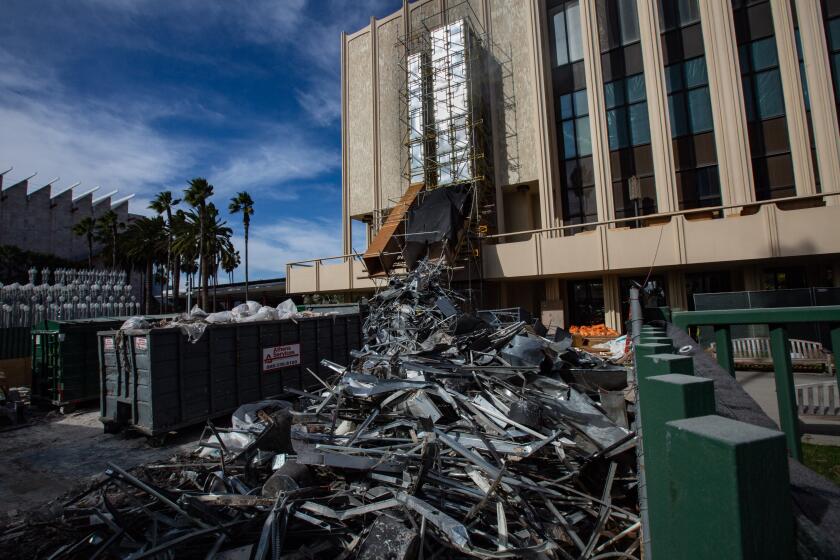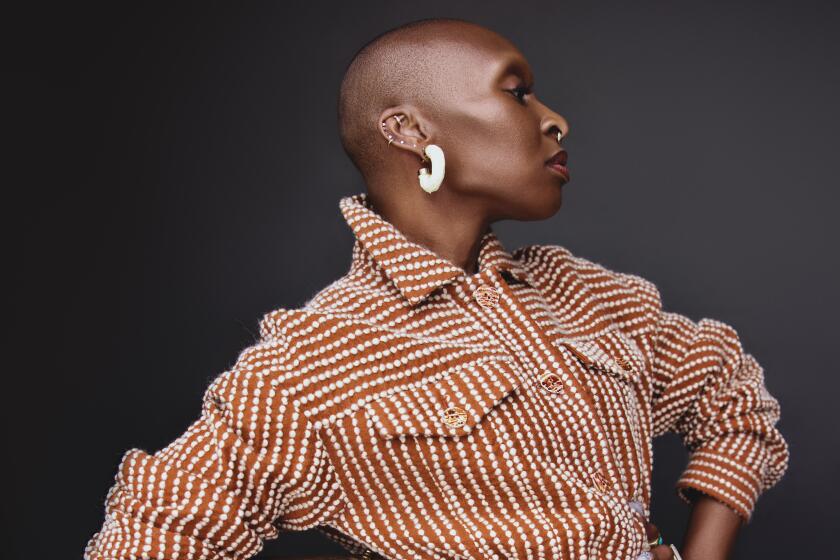Commentary: After giving $130 million in art to LACMA, the Ahmanson Foundation says: No more
- Share via
In a stunning rebuke to the Los Angeles County Museum of Art, a foundation virtually synonymous with the museum for 60 years — and its largest donor of European Old Master paintings and sculptures — has ceased making gifts of art to the museum.
The Ahmanson Foundation was established in 1952 by banker and financier Howard F. Ahmanson, who was also instrumental in the creation and launch of LACMA nearly a decade later. The foundation that bears his name has donated more than $130 million in important Italian, French, Dutch, Flemish and Spanish art.
This treasure trove includes masterpieces by Fra Bartolomeo, Jacopo Bellini, Rembrandt, Gian Lorenzo Bernini, Watteau, Jacques-Louis David and a host of others. The foundation also underwrote the purchase of LACMA’s signature work: Georges de La Tour’s flawless painting, “The Magdalen With the Smoking Flame” (circa 1635-37), donated in 1977.
The Ahmanson’s gift program, which has paid for 114 paintings and 15 sculptures, is the backbone of the museum’s widely admired European art collection. But now, the foundation has ended the program.
The reason for the rift is the foundation’s dissatisfaction with the change in LACMA format being implemented by Director Michael Govan. His new plan means that the cream of the museum’s esteemed encyclopedic art collections will no longer be on permanent display.
LACMA is on the brink of tearing down three large buildings that display the best of the permanent collection, plus a fourth that contains a large auditorium. They will be replaced with one smaller hall for temporary exhibitions.
Rather than dedicated galleries for permanent collection installations, customary for institutions of LACMA’s size and stature, the new building will instead host changing theme shows drawn from the museum’s holdings of world art.
As a result, Ahmanson gifts acquired over decades at LACMA curators’ specific request will end up in storage for unknown periods of time — even though they were bought for permanent display.
“We’ve been unable to get a commitment from Michael Govan about presenting the collection as it has been throughout the life of the museum,” foundation President William Ahmanson explained following lunch at a restaurant a short walk from his office, just up the street from the museum. His late father, Robert Ahmanson, the founder’s nephew, oversaw the LACMA gift program for more than three decades.
A relationship of trust had developed between LACMA and the Ahmanson Foundation. Each year, museum curators would propose specific purchases to the foundation, which invariably made the acquisition and then donated the work to LACMA. Paintings and sculptures have been given without the encumbering restrictions sometimes demanded by private collectors.
In 2006, William Ahmanson said, the foundation received a letter from Govan, who had recently been appointed to the museum’s top job. He wrote to assure them of “at least equal and probably much better space” for the art in a new building.
As the design unfolded, however, it was increasingly clear that was not to be. “We’ve been trying,” Ahmanson said, “to get clarification and confirmation of that pledge for years.”
LACMA did not publicly reveal this radical change in museum format until nearly 10 years into the lengthy redesign process.
One current LACMA structure slated for the wrecking ball is the Ahmanson Building, where collections of Indian, Southeast Asian and Modern art, as well as the European collection, have long been housed. The new replacement exhibition hall will be named the David Geffen Galleries, recognizing the entertainment mogul’s $150 million construction pledge.
Ahmanson insists, however, that losing a named building is not what is driving the foundation’s complaint. His fear is that many works will languish in storage.
“Our greatest concern,” he said, “is that the public has access to the art we’ve provided throughout LACMA’s history.”
The museum is aware of the foundation’s concerns. Last year, for the first time since the Ahmanson’s gift program began in 1972, the foundation rebuffed LACMA’s request to buy a work of art. In January 2019 the foundation declined to pay the $550,000 being asked for a 17th century Italian Baroque painting that was a good fit for the museum’s collection.
The rejection amounted to an expression of “no confidence” in the museum’s new building and the revised program plan. Demolition of the four existing buildings is scheduled to begin next month, with completion of the new facility, designed by Swiss architect Peter Zumthor, slated for 2024.
In response to an inquiry from The Times, Govan framed the Ahmanson decision as merely a pause in the program during construction. The statement continued: “We are immensely grateful for the Foundation’s long-standing generosity to LACMA and look forward to featuring the gifts from the Ahmanson Foundation as soon as we have completed our new galleries, just four years from now.”
The historic collecting relationship forged between the Ahmanson Foundation and the museum was unique — and widely envied. J. Patrice Marandel, LACMA senior curator of European art for nearly a quarter-century until his 2017 retirement, recommended scores of purchases. He is shocked by the split.
“The Ahmanson Foundation is in the DNA of LACMA,” Marandel said in a recent telephone conversation.
When the museum opened its doors on Wilshire Boulevard in 1965, the permanent collection was modest, much of it only on loan from private collectors. In 1972, with the settlement of Howard Ahmanson’s estate four years after his death, the company that bore his name gave LACMA his prized early Rembrandt, “The Raising of Lazarus,” painted when the artist was in his mid-20s. The darkly mysterious panel helped propel the young museum’s collecting ambitions and remains among its most significant works.
Michael Govan responds to critics who say building a new Peter Zumthor-designed complex will leave the museum swimming in debt. With demolition just weeks away, we look at LACMA’s tax forms and current debt load.
Robert Ahmanson soon ignited the plan to build the museum’s European art collection through a program of regular gifts. Acquisitions have been carefully chosen to fill collection gaps and to clarify art’s history for visitors.
To acquire a theatrical vision of a desperate, dying mother and child saved by an angel in a panel painting by Pieter Lastman, Rembrandt’s teacher, has merit in its own right. But it also illuminates the dramatic form of his student’s “The Raising of Lazarus,” in which a corpse comes back to life. Next, adding a picture that shows a tense moment in a Roman myth about mortality by Carel Fabritius, Rembrandt’s pupil, brings into view a chain of cultural continuity and transformation.
Like most art museums, LACMA has never had substantial acquisition funds. Necessary layers of curatorial, administrative and trustee committees also slow the arduous collecting process. A private foundation with means — the Ahmanson has assets of more than $1.2 billion — can act nimbly.
A prime example unfolded in 1997. Museums can rarely compete at auction, where the ceiling price is unknown and lightning-quick decisions must be made. At a hotly contested Sotheby’s auction in New York, the foundation bested the century-old Museum of Fine Arts, Boston, and bought for LACMA “Plague in an Ancient City” (1648-1659), one of the greatest works by the enigmatic Flemish Baroque master Michael Sweerts. The large painting was hammered down at $3.8 million.
A LACMA publication later described the brilliant acquisition as having “inspired dozens of letters of congratulations from museum colleagues.” Close cooperation among the foundation, curator Marandel and Daniel N. Belin, then chairman of the museum’s board of trustees, made the coup possible.
Ahmanson gifts include signal masterpieces and other works that tell nuanced stories of art in Europe between the late 15th and early 19th centuries. The core, however, is Western Europe’s 17th century Baroque era, especially in Italy and France. LACMA, as a young museum without a significant collection, made the savvy early decision to focus its European collecting on a period then somewhat out of fashion. Today, however, it is in great demand.
By the time William Ahmanson became foundation president in 2007, the superlative track record of the art-buying gift program had transformed LACMA’s once-thin holdings in European art.
The 1970s saw the arrival of major examples by Chardin, Veronese and Frans Hals, plus the spectacular La Tour. The 1980s greeted the Bellini, a Titian and a Hendrick Goltzius masterpiece, with exceptional works added in the 1990s by Gerrit van Honthorst, the unidentified Master of the Fiesole Epiphany and the outstanding Sweerts.
The 21st century has added exquisite private altarpieces by Venetian Renaissance painter Cima da Conegliano and Bolognese Mannerist Lavinia Fontana, arguably Europe’s first female career artist. An idealized, even virginal vision of Saint Martina by Pietro da Cortona, thought to have originally graced Rome’s incomparable Barberini Palace, joined a roiling, rediscovered scene of “The Ecstasy of Saint Francis” by Giovanni Baglione, a Roman painter in the circle of Caravaggio.
In 2009, the Ahmanson Foundation became the lead donor among eight others in a race to put together $10 million to prevent the imminent loss of Hendrick Avercamp’s stellar “Winter Scene on a Frozen Canal,” circa 1620 — the only one of 36 paintings from the celebrated Carter Collection of Dutch landscapes and still lifes being sold rather than bequeathed to LACMA. The incomparable picture, likely to have disappeared into a private collection, was saved for public view.
The list goes on.
Apparently, however, the list has come to an end. In 2017, the Ahmanson bought its last LACMA gift — an elaborate, $2.5 million bronze sculpture of Saint John baptizing Christ by Alessandro Algardi, Bernini’s only rival in Rome. That same year, Marandel retired.
No request for a purchase was made in 2018, perhaps signaling rising tensions between museum and patron. According to William Ahmanson, the bond also frayed when LACMA’s Govan suggested changing the foundation’s gift focus to buying Latin American art — a surprising request from a museum director to a proven major patron in another field. The foundation demurred.
Last year, the refusal of an appeal to acquire a large, lively Baroque canvas by Genoese painter Valerio Castello signaled the demise of the once-thriving arrangement between foundation and museum. The foundation likely had to be thinking, why buy a painting that might not be shown? The private London art dealer who made the work available for public acquisition has since removed it from the market.
The Los Angeles County Museum of Art will start demolition soon on its midcentury campus. In New York, MoMA partially proves the power of a different approach.
What is next for the Ahmanson Foundation? In addition to art, it gives grants to support programs in education, health care, specialized libraries, homelessness and the environment, principally in Los Angeles. Modest supporting grants for art conservation and research are still being made to LACMA, and the foundation’s president remains a museum trustee.
But the plug has been pulled on the key program — gifts of art — at least to LACMA.
“If we are to continue in this space,” Ahmanson said in an email, “then we may need to find a beneficiary other than the Los Angeles County Museum of Art.”
I suspect he won’t have much trouble locating prospective partners. LACMA, on the other hand, faces an uncertain future: Burning a leading donor does not inspire confidence among other collectors.
More to Read
The biggest entertainment stories
Get our big stories about Hollywood, film, television, music, arts, culture and more right in your inbox as soon as they publish.
You may occasionally receive promotional content from the Los Angeles Times.












